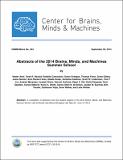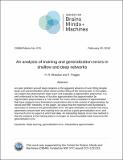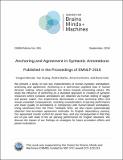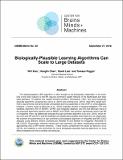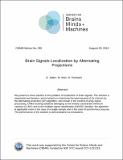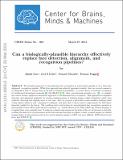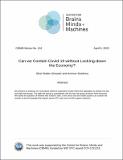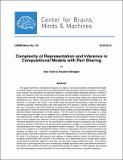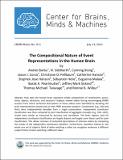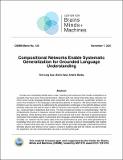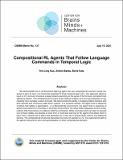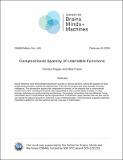Browsing CBMM Memo Series by Title
Now showing items 1-20 of 141
-
3D Object-Oriented Learning: An End-to-end Transformation-Disentangled 3D Representation
(2017-12-31)We provide more detailed explanation of the ideas behind a recent paper on “Object-Oriented Deep Learning” [1] and extend it to handle 3D inputs/outputs. Similar to [1], every layer of the system takes in a list of ... -
Abstracts of the 2014 Brains, Minds, and Machines Summer School
(Center for Brains, Minds and Machines (CBMM), 2014-09-26)A compilation of abstracts from the student projects of the 2014 Brains, Minds, and Machines Summer School, held at Woods Hole Marine Biological Lab, May 29 - June 12, 2014. -
An analysis of training and generalization errors in shallow and deep networks
(Center for Brains, Minds and Machines (CBMM), arXiv.org, 2019-05-30)This paper is motivated by an open problem around deep networks, namely, the apparent absence of overfitting despite large over-parametrization which allows perfect fitting of the training data. In this paper, we analyze ... -
An analysis of training and generalization errors in shallow and deep networks
(Center for Brains, Minds and Machines (CBMM), arXiv.org, 2018-02-20)An open problem around deep networks is the apparent absence of over-fitting despite large over-parametrization which allows perfect fitting of the training data. In this paper, we explain this phenomenon when each unit ... -
Anchoring and Agreement in Syntactic Annotations
(Center for Brains, Minds and Machines (CBMM), arXiv, 2016-09-21)Published in the Proceedings of EMNLP 2016 We present a study on two key characteristics of human syntactic annotations: anchoring and agreement. Anchoring is a well-known cognitive bias in human decision making, where ... -
Biologically Inspired Mechanisms for Adversarial Robustness
(Center for Brains, Minds and Machines (CBMM), 2020-06-23)A convolutional neural network strongly robust to adversarial perturbations at reasonable computational and performance cost has not yet been demonstrated. The primate visual ventral stream seems to be robust to small ... -
Biologically-Plausible Learning Algorithms Can Scale to Large Datasets
(Center for Brains, Minds and Machines (CBMM), 2018-09-27)The backpropagation (BP) algorithm is often thought to be biologically implausible in the brain. One of the main reasons is that BP requires symmetric weight matrices in the feedforward and feed- back pathways. To address ... -
Biologically-plausible learning algorithms can scale to large datasets
(Center for Brains, Minds and Machines (CBMM), arXiv.org, 2018-11-08)The backpropagation (BP) algorithm is often thought to be biologically implausible in the brain. One of the main reasons is that BP requires symmetric weight matrices in the feedforward and feedback pathways. To address ... -
Brain Signals Localization by Alternating Projections
(Center for Brains, Minds and Machines (CBMM), arXiv, 2019-08-29)We present a novel solution to the problem of localization of brain signals. The solution is sequential and iterative, and is based on minimizing the least-squares (LS) criterion by the alternating projection (AP) algorithm, ... -
Bridging the Gaps Between Residual Learning, Recurrent Neural Networks and Visual Cortex
(Center for Brains, Minds and Machines (CBMM), arXiv, 2016-04-12)We discuss relations between Residual Networks (ResNet), Recurrent Neural Networks (RNNs) and the primate visual cortex. We begin with the observation that a shallow RNN is exactly equivalent to a very deep ResNet with ... -
Building machines that learn and think like people
(Center for Brains, Minds and Machines (CBMM), arXiv, 2016-04-01)Recent progress in artificial intelligence (AI) has renewed interest in building systems that learn and think like people. Many advances have come from using deep neural networks trained end-to-end in tasks such as object ... -
Can a biologically-plausible hierarchy e ectively replace face detection, alignment, and recognition pipelines?
(Center for Brains, Minds and Machines (CBMM), arXiv, 2014-03-27)The standard approach to unconstrained face recognition in natural photographs is via a detection, alignment, recognition pipeline. While that approach has achieved impressive results, there are several reasons to be ... -
Can we Contain Covid-19 without Locking-down the Economy?
(Center for Brains, Minds and Machines (CBMM), 2020-03-26)We present an analysis of a risk-based selective quarantine model where the population is divided into low and high-risk groups. The high-risk group is quarantined until the low-risk group achieves herd-immunity. We tackle ... -
Classical generalization bounds are surprisingly tight for Deep Networks
(Center for Brains, Minds and Machines (CBMM), 2018-07-11)Deep networks are usually trained and tested in a regime in which the training classification error is not a good predictor of the test error. Thus the consensus has been that generalization, defined as convergence of the ... -
Complexity of Representation and Inference in Compositional Models with Part Sharing
(Center for Brains, Minds and Machines (CBMM), arXiv, 2015-05-05)This paper performs a complexity analysis of a class of serial and parallel compositional models of multiple objects and shows that they enable efficient representation and rapid inference. Compositional models are generative ... -
The Compositional Nature of Event Representations in the Human Brain
(Center for Brains, Minds and Machines (CBMM), arXiv, 2014-07-14)How does the human brain represent simple compositions of constituents: actors, verbs, objects, directions, and locations? Subjects viewed videos during neuroimaging (fMRI) sessions from which sentential descriptions of ... -
Compositional Networks Enable Systematic Generalization for Grounded Language Understanding
(Center for Brains, Minds and Machines (CBMM), Conference on Empirical Methods in Natural Language Processing (EMNLP), 2021-11-07)Humans are remarkably flexible when under- standing new sentences that include combinations of concepts they have never encountered before. Recent work has shown that while deep networks can mimic some human language ... -
Compositional RL Agents That Follow Language Commands in Temporal Logic
(Center for Brains, Minds and Machines (CBMM), Frontiers in Robotics and AI, 2021-07-19)We demonstrate how a reinforcement learning agent can use compositional recurrent neural net- works to learn to carry out commands specified in linear temporal logic (LTL). Our approach takes as input an LTL formula, ... -
Compositional Sparsity of Learnable Functions
(Center for Brains, Minds and Machines (CBMM), 2024-02-08)Neural networks have demonstrated impressive success in various domains, raising the question of what fundamental principles underlie the effectiveness of the best AI systems and quite possibly of human intelligence. This ... -
Compositional Sparsity: a framework for ML
(Center for Brains, Minds and Machines (CBMM), 2022-10-10)The main claim of this perspective is that compositional sparsity of the target function, which corre- sponds to the task to be learned, is the key principle underlying machine learning. I prove that under restrictions of ...


